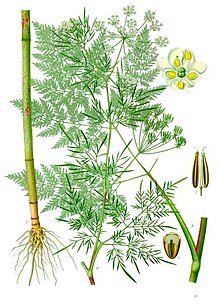Apiaceae: Difference between revisions
rm color to allow taxobox autocoloration and remove vandalism magnet |
No edit summary |
||
| Line 57: | Line 57: | ||
*[http://rbg-web2.rbge.org.uk/URC/frames.html?http://rbg-web2.rbge.org.uk/URC/urchomepage.html Umbellifer Resource Centre] |
*[http://rbg-web2.rbge.org.uk/URC/frames.html?http://rbg-web2.rbge.org.uk/URC/urchomepage.html Umbellifer Resource Centre] |
||
*[http://www.umbelliferae.cs.msu.su/en_index.php?menu_item_id=4 Umbellifer Information Server] |
*[http://www.umbelliferae.cs.msu.su/en_index.php?menu_item_id=4 Umbellifer Information Server] |
||
*[http://flowersinisrael.com/FamApiaceae.html Family Apiaceae] - Flowers in Israel |
|||
[[Category:Plant families]] |
[[Category:Plant families]] |
||
Revision as of 18:30, 5 March 2008
| Carrot family | |
|---|---|
| File:HeracleumSphondyliumInflorescence.jpg | |
| Inflorescence of Common Hogweed (Heracleum sphondylium) | |
| Scientific classification | |
| Kingdom: | |
| Division: | |
| Class: | |
| Order: | |
| Family: | Apiaceae (or Umbelliferae) |
| Type genus | |
| Apium | |
| Genera | |
|
including:
For complete list, see List of Apiaceae genera. | |
The Apiaceae or Umbelliferae (both names are allowed by the ICBN) is a family of usually aromatic plants with hollow stems. It includes cumin, parsley, carrot, coriander / cilantro, dill, caraway, fennel, parsnip and other relatives. It is a large family with about 300 genera and more than 3,000 species. The earlier name Umbelliferae derives from the inflorescence being in the form of a compound "umbel".
The small flowers are radially symmetrical with 5 small sepals, 5 petals and 5 stamens.
The family includes some highly toxic plants, such as hemlock. Many plants in this family, such as wild carrot have estrogenic properties, and have been used as folk medicine for birth control. Most notable for this use is the extinct giant fennel, silphium. The cultivated plants in this category are almost all considered good companion plants, as the umbrella of tiny flowers attracts omnivorous beneficial insects, especially parasitic wasps and predatory flies, which then will hunt insect pests on nearby crops.
The family is closely related to Araliaceae and the boundaries between these families remain unclear. Some recent systems include Araliaceae in an expanded Apiaceae but this has not been widely followed. Hydrocotyle and Trachymene, traditionally included in Apiaceae, are now generally included in Araliaceae.
Notable members include Anethum graveolens - Dill, Anthriscus cerefolium - Chervil, Angelica spp. - Angelica, Apium graveolens - Celery, Arracacia xanthorrhiza - Arracacha, Carum carvi - Caraway, Centella asiatica - Gotu Kola (pennywort), Conium maculatum - Poison hemlock, Coriandrum sativum - Coriander, Cuminum cyminum - Cumin, Daucus carota - Carrot, Eryngium spp. - Sea holly, Foeniculum vulgare - Fennel, Myrrhis odorata - Cicely, Pastinaca sativa - Parsnip, Petroselinum crispum - Parsley, Pimpinella anisum - Anise, Levisticum officinale - Lovage


from Medical botany by William Woodville. London, James Phillips, 1793
See also
External links
- UVSC Herbarium - Apiaceae
- Umbellifer Resource Centre
- Umbellifer Information Server
- Family Apiaceae - Flowers in Israel
